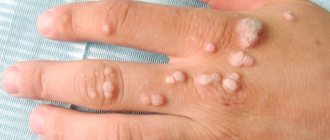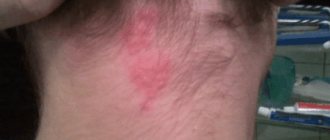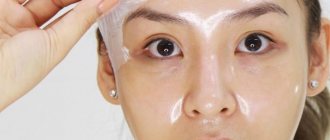Possibility of unforeseen consequences
Laser correction of moles is one of the safest ways to get rid of nevus, avoiding complications and unforeseen consequences. A beam of directed light radiation literally evaporates the pigmented cells of moles, which is visually manifested by the complete removal of the epidermal formation in just a few minutes. Minimization of negative consequences occurs due to the following objective factors.
- The laser beam acts in a strictly targeted and selective manner, without injuring healthy skin structures, which allows the technique to be used even to remove the smallest nevi in the eyelid area and mucous membranes;
- There is virtually no risk of infection, since the laser exhibits a powerful antibacterial and antimicrobial effect, protecting the wound surface from infection;
- Laser destruction is not accompanied by bleeding or hemorrhage, since during the manipulation process all blood capillaries supplying the body of the mole undergo thermal coagulation;
- The laser activates regenerative processes in the skin, which significantly accelerates wound healing;
- The technique is low-traumatic, which avoids the formation of connective tissue and all the negative consequences associated with this factor.
Despite the safety of the method, it should be borne in mind that before the procedure it is necessary to carefully study the list of contraindications, since the consequences and complications of laser correction most often result from neglect of this list, which includes the following conditions:
- Pregnancy;
- Acute infectious process;
- Oncology of any localization;
- Inflammation in the intended area of laser exposure;
- Period of menstruation in women;
- Immunodeficiency;
- Exacerbation of chronic pathologies;
- Hyperthermia.
Seals under a mole, is it dangerous?
Often, if you have a mole (nevus), you can see a small lump located somewhere around the mole or just below. No one can say whether they are dangerous or not without proper inspection. Only after specialists have seen, touched and examined can we talk about the results and the degree of their danger. In most cases, such seals do not pose any danger. But there are many exceptions. Only a specialist will be able to draw the correct conclusion.
Is it necessary to remove a nevus with compaction?
By their nature, ordinary nevi do not pose any threat. If they are symmetrical, do not increase in size, do not change color, do not bleed, do not crack or cause anxiety, there is no need to remove them. Whether they are with or without a seal does not matter at all, the main thing is that they do not change and do not cause discomfort (except for aesthetic reasons, of course). It is better to consult a doctor to calm your nerves, but usually they do not pose any danger, but simply exist as an integral part of the human body.
Current issues
Most patients, after undergoing a laser mole removal procedure, observe some characteristic reactions of the body during the first two weeks, some of which are normal responses that are compensatory in nature. Let's consider several pressing issues regarding the consequences of removing nevi on the face and body.
Can cancer occur after mole removal? Skin cancer, or melanoma, usually develops as a consequence of the malignant transformation of a melanoma-prone mole. Moreover, if during the laser correction process the specialist incorrectly determined the required depth of the beam and did not completely remove the mole, the risk of developing melanoma increases.
After removal, a tubercle appeared. Despite the low-invasiveness of the technique, in the process of removing the nevus, healthy surrounding tissue remains, which will have to undergo the healing process of the wound surface that has formed in place of the mole. In this case, this zone can form a small tubercle, which will be covered with a dense crust in a few days. This is considered a normal reaction to manipulation.
Inflammation after removal of a birthmark. The inflammatory process after laser correction usually lasts for the first days, after which it goes away. If inflammatory signs persist for a long time, you must immediately contact the specialist who performed the procedure.
Can a scar or scar form after removal of a nevus? The formation of scars can only be observed in the case of forced premature removal of the protective crust from the wound surface.
The scar itches and hurts after mole removal. Itching, burning, peeling and redness around a mole after removal are characteristic symptoms of a burn, which can be caused by unprofessional work of a doctor. This unpleasant complication develops if the specialist incorrectly determined the depth of exposure and subjected healthy skin cells to laser burning.
How to treat
Modern medicine has a number of methods for getting rid of hypertrophic scars. Red spots after mole removal can be removed in several ways. The most popular is drug treatment.
Medicines are used most often in cases where the scar is not yet fully formed. The doctor prescribes corticosteroid medications that are injected directly into the scar tissue. Due to their effects, the production of collagen is suppressed and the synthesis of fibroblasts is reduced. Over time, the stain softens and acquires a natural color.
The course of treatment consists of several injections, which are administered every two weeks. But with such long-term use of drugs, side effects are possible. Most often, atrophy, acne and lightening of the skin area are observed.
In exceptional cases, there is a disturbance in the menstrual cycle in women. In order to reduce the risk of side effects, the drugs are administered once every 2-5 days, which significantly reduces the treatment time.
Cryotherapy
Scars are removed using liquid nitrogen. The duration of exposure is several seconds. In this case, the skin is exposed to strong effects of low temperature, resulting in degeneration of the cell surface.
After the procedure, the surface of the skin is cleaned and a drug is injected to activate the synthesis of fibroblasts.
Surgical correction
The essence of the procedure is the excision of a scar or cosmetic transplantation of the upper layer of the epidermis. As a result, a new scar appears in place of the hypertrophied scar, but it is correct from a cosmetic point of view.
Why can our articles be trusted?
We make health information clear, accessible and relevant.
- All articles are checked by practicing doctors.
- We take scientific literature and the latest research as a basis.
- We publish detailed articles that answer all questions.
The healing process can be corrected. But surgical correction is a radical method of removing red spots after excision of moles.
Doctors recommend using it when other methods of getting rid of hypertrophied scars do not help.
X-ray therapy. The destruction of collagen cells occurs under the influence of X-ray radiation. As a result, the necessary balance is achieved and the formation of fibrous tissue does not occur.
Chemical peeling or microdermabrasion
They are highly effective only in the presence of small scars that are not prone to reappearance.
Silicone patches. But this method is not very popular, since the positive effect is achieved after a large amount of vision. The duration of treatment is about a year, and a positive result is observed in one third of patients.
Laser coagulation
Carbon dioxide and erbium lasers are used to remove fibrous tissue. A positive result is achieved by exposing the upper layer of the epidermis to a laser beam. After which collagen synthesis and fibrocyte activity increase significantly.
When a red spot does not go away after mole removal for a long time, you should consult a doctor. There may be several reasons for its appearance. The treatment method depends on the size of the hypertrophied area of the skin. The choice depends on the location of the scar, its size and other factors.
Care after laser mole removal
If the laser ablation procedure was performed by a qualified specialist, the risk of side effects is minimal, but the patient will also have to follow certain post-procedure rules, listed below.
- It is necessary to provide rest to the wound surface, without injuring it by friction of clothing or shoes, and also by taking care of the protective crust;
- Contact of the wound with water should be avoided for two weeks after manipulation;
- It is recommended to protect the skin surface from direct sunlight, and also use creams with a high UV protection factor. To the question of when you can sunbathe after removing a mole, the answer will be at least three weeks;
- You cannot use ointments, creams and gels for healing on your own without a doctor’s prescription;
- The procedure area should be protected from any mechanical damage, carefully protecting the integrity of the protective scab.
Laser removal is one of the simplest and least traumatic methods of mole destruction. Compliance with simple rules of rehabilitation will allow you to avoid scars, cicatrices and other unpleasant consequences and obtain an ideal physiological and aesthetic result.
How is the mole removal procedure performed?
What is laser mole removal ? If the neoplasm is quite large, then first the upper part of the mole is surgically cut off. The lower one is removed using a high-precision laser to the very root. Laser removal is absolutely painless and safe. The only discomfort this procedure causes is that the site of the former mole may be very itchy during healing. But it is not difficult to get rid of this if you follow all the instructions of your doctor. He will prescribe special healing medications that will help cope with the negative consequences.
Laser technology is also applicable to remove papillomas and other skin growths.
The process of removing moles with a laser takes only about 20-60 minutes, depending on the size of the neoplasm and its depth. And most often, just one procedure of laser removal of tumors is enough to forget about the annoying problem forever. Only in extremely rare cases will additional therapy be required.
You can find photos after removing a mole directly on our website. It is not difficult to notice that the healing process takes approximately 5 months. And it is after using the laser that the reviews after mole removal are the most positive. There are no wounds, no pain, or any other discomfort. After the procedure, you can return to your normal life, no longer afraid of damaging the mole or relapse. This is excluded if you had the removal performed in our clinic.
By the way, it wouldn’t hurt to take a photo of the place after removing the mole. This way you can make sure that after a while the formation does not begin to grow again.
How long will the healing process take?
Many are also interested in the question: how long does it take for a mole to heal after removal? This depends on many indicators, ranging from the area of skin that was exposed to the laser to the depth of impact on the epidermis. At the same time, the healing process is in many ways very individual. For some this process takes several weeks, for others it takes 6 months. Here the regenerative qualities of each patient’s body play a big role.
But in general, there are general stages that healing after laser mole removal in Moscow involves. Initially, the formation may take on a slightly darkish tint. In this case, most often a small notch is formed after the laser. After just a few weeks, there will be no indentation at all, only a small pigment spot will remain, which will completely disappear after 5 months. The place where the mole was previously will take on a slightly lighter shade. This can easily be eliminated with regular tanning.
If you are very concerned that after removing a mole with a CO2 laser, there will be no noticeable mark left, you can consult a cosmetologist. He will prescribe the use of certain ointments that will help speed up the healing process. But still, experts recommend doing without medications at this stage. The scar will not be visible only when it heals at the normal speed that the regenerative function of the human body allows.
Are there complications after mole removal?
Only if the procedure was performed by an inexperienced doctor without prior research. The biggest risk is when a small part of the mole (just a few cells) may remain. This will be enough for it to start growing again, but as melanoma. Therefore, you should immediately emphasize to yourself that negative consequences after removing a mole can only arise when the procedure is performed by an inexperienced doctor. Therefore, approach the issue of choosing a clinic responsibly. By the way, the removal of warts must also be carried out especially carefully and completely, since the remaining cells lead to more intensive growth of a new wart.
Laser mole removal in Moscow at the LazerJazz clinic is carried out only by professional specialists using methods accepted throughout the world. Particular attention is paid to preparing for the procedure, determining the safest method and establishing possible contraindications to laser mole removal.
Briefly about the main thing:
Recurrence of nevus, i.e.
a brown spot at the site of removal may be hazardous to health in rare cases. The likelihood of developing melanoma after removal increases if neither dermatoscopy, nor scraping/puncture, nor histological examination were performed . If this is exactly what happened to you, please consult an oncologist about re-excision with histology.
If you still have questions about the removed mole, you can ask me in the online consultation section or come to an appointment at the address in St. Petersburg - Asafieva 7/1.
Causes of nevus recurrence
In most cases, the nevus appears again, because... the mole that existed before it was not completely removed. Some of the nevus cells remained in the skin and after some time began to actively produce brown pigment (melanin). This is what we see at the site of the mole some time after removal. At the same time, in my practice there are already 5 cases where a relapse of the nevus developed after complete removal of the mole. Why this happens and where nevus cells appear where there were none are questions that, so far, have no answer.










